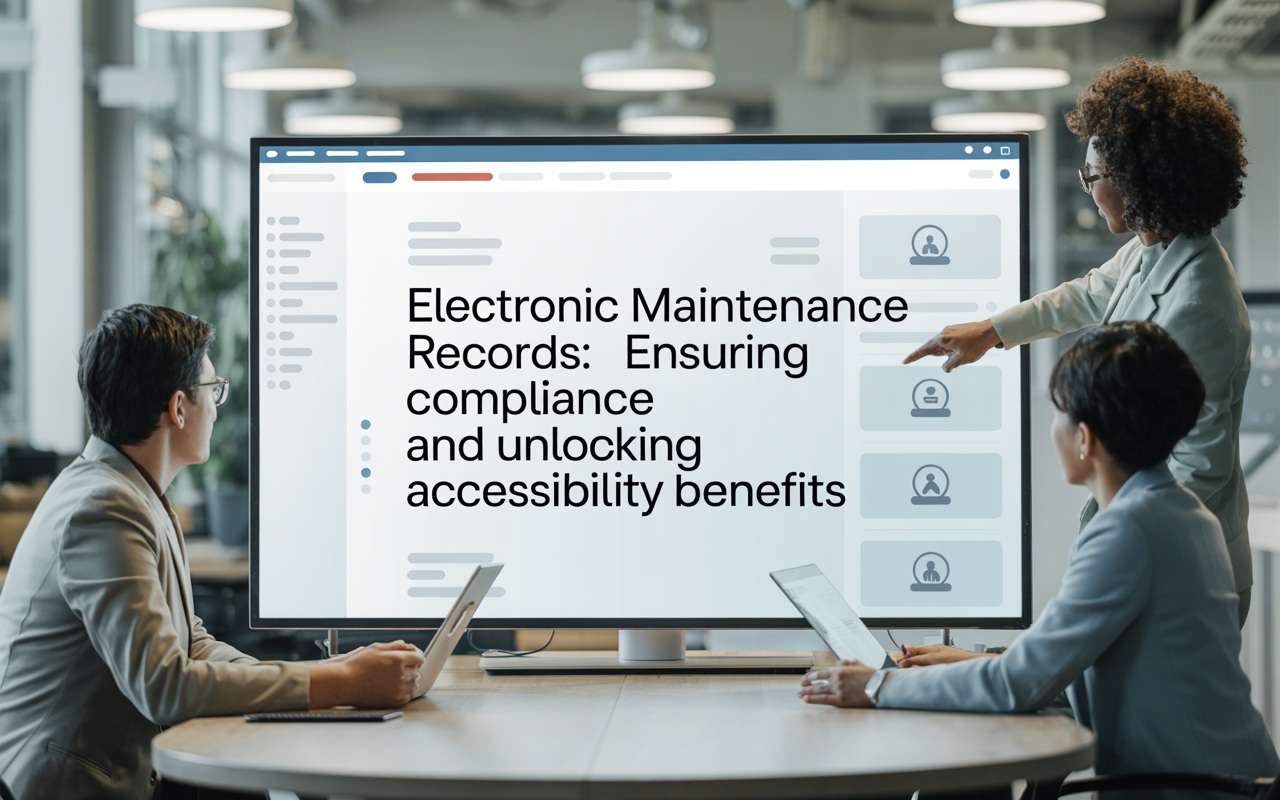Electronic Maintenance Records: Ensuring Compliance and Unlocking Accessibility Benefits
Introduction
In today’s fast-paced digital world, industries are rapidly adopting electronic maintenance records (EMRs) to streamline operations and boost efficiency. 🌐 These systems replace outdated paper-based logs with modern, cloud-enabled solutions that offer real-time insights and better data management. As businesses increasingly rely on data for decision-making, understanding the compliance and accessibility benefits of EMRs becomes critical.
This article dives into what electronic maintenance records are, why they matter for legal compliance, and how they enhance accessibility for teams across industries. We’ll also explore practical tips for implementation, industry case studies, and frequently asked questions. By the end, you’ll have a clear picture of how EMRs can transform your organization’s record-keeping processes. Let’s get started! 🚀
What Are Electronic Maintenance Records?
Electronic maintenance records (EMRs) are digital systems designed to store, track, and manage maintenance activities for equipment, machinery, and facilities. Unlike traditional paper logs or spreadsheets, EMRs use cloud technology to centralize data, making it easier to access, update, and analyze. Features like automated updates, audit trails, and customizable reporting make these systems indispensable for modern businesses. 🔧
Industries such as healthcare, aviation, manufacturing, and transportation rely heavily on EMRs to ensure their assets remain in optimal condition. For example, hospitals use EMRs to track medical device servicing, while airlines maintain detailed logs for aircraft inspections. By transitioning to electronic records, organizations benefit from improved accuracy, reduced manual effort, and enhanced collaboration. Now, let’s explore why compliance is a key driver for adopting EMRs. 📝
Legal and Regulatory Compliance: Why Electronic Records Matter
Compliance with legal and regulatory standards is non-negotiable for many industries. Agencies like OSHA, FDA, FAA, and DOT mandate detailed maintenance records to ensure safety, quality, and accountability. Failure to comply can result in hefty fines, lawsuits, or even operational shutdowns. 😬
Electronic maintenance records simplify compliance by providing standardized formats, automated reporting, and secure storage. During audits, having a centralized, tamper-proof system ensures that all required documentation is readily available. This not only reduces stress but also minimizes the risk of human error or missing information. 📊
Moreover, EMRs support proactive risk management by enabling predictive maintenance. For instance, tracking wear-and-tear patterns helps prevent equipment failures that could lead to accidents or downtime. With tools like those offered by Nektar.io, organizations can ensure their EMR systems align with industry-specific compliance needs. By leveraging technology, businesses stay ahead of regulatory demands while safeguarding their operations. 💼
“Maintenance logs and service records can also help ensure compliance with required industry standards and audits, including Occupational Safety and Health Administration rules. In case an incident occurs, detailed records of your maintenance records may help mitigate liability, fines, and legal complications.”-RedBeam
Accessibility: Making Maintenance Data Available When and Where It’s Needed
Accessibility goes beyond mere compliance-it’s about empowering teams with instant access to critical information. Whether it’s a field technician troubleshooting a machine or a manager reviewing performance metrics, EMRs ensure that data is available anytime, anywhere. Cloud-based platforms enable authorized users to retrieve records remotely, eliminating delays caused by physical logbooks or office visits. 🌍
Mobile technologies further enhance accessibility by allowing users to view and update records directly from smartphones or tablets. Imagine a factory supervisor receiving real-time alerts about equipment issues and resolving them on the spot. This level of responsiveness boosts productivity and fosters collaboration among dispersed teams. Next, we’ll discuss how digital accessibility standards play a role in ensuring inclusivity for all users. 👥
“A digital record can potentially be accessed by anyone in the country (assuming they have authorization to view the record) as opposed to having to be on-site or having to wait to have a record shipped to a new location.”-TAGOVCloud
Section 508, ADA, and Digital Accessibility Standards
Digital accessibility is more than just a buzzword-it’s a legal requirement for many organizations, especially government agencies and contractors. Section 508 of the Rehabilitation Act and the Americans with Disabilities Act (ADA) set guidelines to ensure electronic records are usable by individuals with disabilities. This includes features like screen reader compatibility, adjustable text sizes, and color contrast adjustments. ✅
To comply with these standards, EMR systems must be designed with accessibility in mind. Best practices include using semantic HTML, providing alternative text for images, and testing interfaces with assistive technologies. By prioritizing accessibility, businesses not only meet legal obligations but also create a more inclusive environment for all employees and stakeholders. After all, accessible design benefits everyone! 🙌
“Everyone benefits when all information is accessible to all users. Studies show that user experience optimizations made for accessibility also benefit people without disabilities.”-Quality Associates Inc.
Enhanced Communication and Transparency Across Teams
One of the standout advantages of EMRs is their ability to foster clear communication and transparency. Gone are the days of deciphering illegible handwriting or searching through stacks of paperwork. With EMRs, every team member works from the same up-to-date source of truth, reducing misunderstandings and errors. 🤝
This unified approach enhances trust and accountability within organizations. For example, maintenance teams can easily share progress updates with supervisors, while executives gain visibility into overall asset performance. The result? Smoother workflows, faster decision-making, and a culture of openness. Now, let’s examine how EMRs contribute to security and risk mitigation. 🔐
“Electronic patient records improve communication comprehension by providing clear, readable, and user-friendly formats. Formatted electronic notes are easier to read than hand-scribbled ones.”-Gamma Compliance
Audit Trails, Security, and Risk Mitigation
Security is a top priority when managing sensitive maintenance data. EMRs automatically generate audit trails, which log every action taken within the system-such as who accessed a record and when changes were made. These logs serve as a safeguard against unauthorized access or tampering, ensuring data integrity at all times. 🛡️
Beyond security, EMRs help mitigate risks associated with non-compliance and operational inefficiencies. For instance, if an incident occurs, having a detailed audit trail can prove invaluable during investigations. Additionally, features like role-based access control and encryption protect sensitive information from cyber threats. By partnering with experts like Nektar.io, organizations can implement robust EMR systems tailored to their unique needs. 💻
“Usability encompasses the design and organization of information, the simplicity of navigation, and the clarity of instructions and feedback. High usability minimizes frustration and errors, enhances user satisfaction, and improves the efficiency of information retrieval.”-TAGOVCloud
Usability: Efficiency and User Satisfaction
A well-designed EMR system prioritizes usability, making it intuitive and efficient for users to navigate. Clear layouts, logical menus, and helpful prompts reduce the learning curve and minimize mistakes. When employees find a tool easy to use, they’re more likely to adopt it enthusiastically. 😊
Improved usability also translates to faster information retrieval and higher productivity. For example, technicians can quickly locate repair histories or service schedules without wasting time searching through cluttered databases. Investing in user-friendly EMR solutions pays off in the long run by boosting satisfaction and streamlining workflows. Speaking of investments, let’s look at the cost savings EMRs bring to the table. 💰
“Making documents accessible in-house can be time consuming and costly, so you may need to find the right technology platform to do it in an automated manner.”-TAGOVCloud
Cost and Resource Savings with Electronic Maintenance Records
Switching to EMRs significantly cuts costs related to physical storage, manual labor, and compliance penalties. Storing paper records requires space, filing cabinets, and ongoing maintenance-expenses that add up over time. Digital systems eliminate these overheads while reducing the risk of lost or damaged documents. 📉
Furthermore, EMRs optimize resource allocation by freeing staff from tedious administrative tasks. Instead of sifting through logs, employees can focus on high-value activities like preventive maintenance and strategic planning. Over time, this leads to measurable returns on investment (ROI) and a leaner, more agile operation. Next, we’ll guide you through choosing the right EMR system for your organization. 🎯
“Preventative maintenance enhances workplace safety by preventing malfunctions that could lead to accidents or injuries.”-RedBeam
Choosing the Right Electronic Maintenance Record System
Selecting an EMR system requires careful consideration of factors like scalability, integration capabilities, and vendor reliability. A scalable solution grows with your business, accommodating additional users, assets, and data without compromising performance. Integration with existing software, such as ERP or CRM systems, ensures seamless data flow across departments. 🔄
Vendor support and reputation are equally important. Look for providers with proven expertise in your industry and a commitment to customer success. Platforms like Nektar.io offer tailored EMR solutions that emphasize accessibility, security, and ease of use. By choosing wisely, you set the foundation for a successful transition to digital record-keeping. But what challenges might arise along the way? Let’s explore. ❓
Challenges and Best Practices for Implementation
Implementing EMRs isn’t without its hurdles. Common challenges include migrating legacy data, training staff, and overcoming resistance to change. However, these obstacles can be managed with proper planning and execution. For example, phased rollouts allow teams to adapt gradually, while hands-on workshops build confidence in using the new system. 🧠
Best practices also involve involving key stakeholders early in the process and setting realistic expectations. Regular feedback loops help identify pain points and refine the implementation strategy. With the right mindset and tools, organizations can overcome these challenges and reap the full benefits of EMRs. To see how others have succeeded, let’s look at some industry examples. 🏭
 Industry Case Examples: Compliance and Accessibility in Action
Industry Case Examples: Compliance and Accessibility in Action
Consider a hospital that adopted EMRs to manage its fleet of diagnostic machines. By digitizing maintenance logs, the facility ensured compliance with FDA regulations and improved response times for repairs. Technicians could access records remotely, leading to quicker resolutions and enhanced patient care. 🏥
In another case, an airline implemented EMRs for aircraft maintenance, achieving greater transparency and adherence to FAA standards. Real-time updates and automated reports streamlined operations, reducing downtime and boosting safety. These examples highlight the transformative power of EMRs across diverse sectors. Now, let’s address some common questions about EMRs. ❓
Frequently Asked Questions
1. What are the main compliance requirements for electronic maintenance records?
Compliance requirements vary by industry but often include standards set by agencies like OSHA, FDA, FAA, and DOT. EMRs help meet these demands by providing structured, auditable, and secure record-keeping solutions. 📑
2. How do electronic records improve accessibility for users?
EMRs enhance accessibility by enabling remote access, supporting mobile devices, and accommodating diverse user needs. Authorized personnel can retrieve records anytime, anywhere, improving efficiency and collaboration. 🌐
3. Are electronic maintenance records secure?
Yes, EMRs employ advanced security measures like encryption, role-based access control, and audit trails to protect sensitive data and prevent unauthorized access. 🔒
4. What is Section 508 and does it apply to my business?
Section 508 requires federal agencies and contractors to make electronic records accessible to individuals with disabilities. If your organization works with the government, compliance may be mandatory. ✅
5. How can I transition from paper to electronic maintenance records?
Transitioning involves digitizing existing records, training staff, and selecting a reliable EMR platform. Partnering with experts like Nektar.io can simplify the process and ensure success. 🤝
Conclusion
Adopting electronic maintenance records offers numerous benefits, from ensuring compliance with stringent regulations to enhancing accessibility and fostering transparency. Businesses that embrace EMRs position themselves for greater safety, efficiency, and cost savings. The advantages extend beyond operational improvements-they also contribute to a culture of accountability and innovation. 🌟
If your organization is still relying on outdated methods, now is the time to review your maintenance record-keeping processes. Explore how modern EMRs, like those provided by Nektar.io, can address your compliance, accessibility, and operational needs effectively. Consult with experts to tailor a solution that fits your goals and take the first step toward a smarter future today! 🚀



